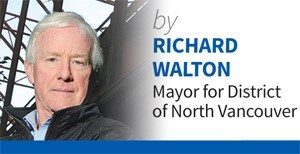Issues relating to trees are seldom off council’s agenda for very long.
Whether the discussion centres on sustaining them or removing them, trees inspire passionate debate amongst residents.
Our identity clearly flows from our forested slopes, our coat of arms is backdropped with the trees we love; yet the reason our community developed was largely due to the economic wealth gained a century ago from cutting them down – the bigger (and older), the better.
But 125 years later we view our trees quite differently. In fact, living near or under the dominant evergreen canopy is one of the reasons many choose to call the district home.
We know now the benefits of preserving our trees. Our foresters tell us that evergreens absorb massive amounts of CO2 in a world experiencing elevated greenhouse gas levels and corresponding warming temperatures. Our 2011 official community plan understands this and makes protecting and enhancing the health of our urban forest a principal objective.
The trees that surround us are very much working trees and, though much of their work is invisible, it is critical to the health and well-being of our environment. Their local presence help ensure we have clean air, and critical wildlife habitat for a healthy, functioning ecosystem. They also play a key role in stabilizing slopes and managing storm water runoff. But to many of our residents trees can also be an immediate nuisance. They obscure views, their debris clogs our eavestroughs and blocks storm drains. Their shade can be a challenge for even the most seasoned home gardener battling slugs, and when they are in poor condition they can pose a risk of failure during windstorms and heavy rain.
Because they are not only a critical part of our ecosystem, but also at times a hazard, managing our biomass is not always simple. Four years ago we developed our tree protection bylaw, which tried to create a balance between regulating, protecting and preserving our urban forest and ecosystem and recognizing our responsibility to minimize risk to people and property.
The bylaw defines which trees in the DNV are protected and may not be removed. Those protected trees include all trees on district land regardless of size, and trees on private property that are over 75 centimetres in diameter. Protected trees also include any trees that are within a streamside protection area, on a steep slope, waterfront or wetland area, are classified as replacement or restricted by covenant, heritage or wildlife trees, or are any of the following species: arbutus, Garry oak, oregon ash, Pacific yew, western white pine and yellow cedar. On private property a permit is also required for the removal or pruning of trees that are over 75 centimetres in diameter and not otherwise protected.
To prune or remove a tree that fits any of the descriptions above, you must get a permit costing $74.50 per tree removed or pruned, and in the case of tree removal only, you are also required to do some replanting to make up for lost canopy cover.
Hazardous trees on private property are special cases, however. For trees deemed hazardous by a certified arborist holding the tree risk assessment qualification, a permit is still required. But the permit fee and replanting requirements are waived if the district’s arborist agrees with the risk assessment.
If you are concerned about a tree on your property, please call a certified arborist and have him or her assess it. If the tree is on district property, call us at 604-990-2311 and our arborist will have it assessed. There is no perfect policy, but our bylaw, updated five years ago, attempts to remove tree care from the political arena and leave it with experts, ensuring that we are striking an appropriate balance between protecting and preserving our trees and maintaining public safety.



